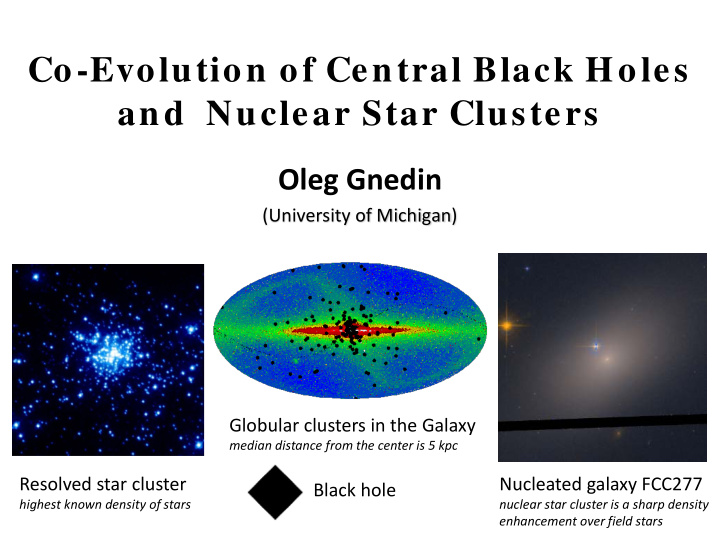



Co-Evolution of Central Black Holes and Nuclear Star Clusters Oleg Gnedin (University of Michigan) Globular clusters in the Galaxy median distance from the center is 5 kpc Resolved star cluster Nucleated galaxy FCC277 Black hole highest known density of stars nuclear star cluster is a sharp density enhancement over field stars
Hydrodynamic cosmological simulations of galaxy formation predict _2 or steeper) → NSC. very high gas density at galaxy center ( 𝜍 ∝ 𝑠 It may be reduced by stellar feedback and massive black hole mergers. 10 kpc Disk galaxy at z=3: stars, molecular gas, atomic gas Zemp, OG, N. Gnedin, Kravtsov (2012)
In most galaxies at low and high redshift, efficiency of star formation on small scales is low: only ≈ 1% of cold gas is converted into stars in one dynamical time star formation rate density gas density per free-fall time Krumholz et al. 2012
Matching numbers of halos and galaxies indicates that star formation is also globally inefficient, especially at low and high galaxy masses 0.17 You are here universal stellar feedback? BH feedback? stellar mass/halo mass baryon fraction ← GC halo mass Conroy et al. 2006, Behroozi et al. 2012
Matching numbers of halos and galaxies indicates that star formation is also globally inefficient, at all redshifts up to z ≈ 4: early star formation has to wait until galaxies get big Behroozi et al. 2013
BUT: fraction of galaxy mass in the globular cluster system is similar in galaxies of (almost) all type and environment, over 5 orders of magnitude in mass group environment Spitler & Forbes (2009) single Georgiev at al. galaxy (2010) environment Harris et al. (2013) Hudson et al. (2014) dwarfs are M GC ≈ (1-5) × 10 -3 M * ≈ 10 -4 M host problem
In addition to in-situ star formation, a Tremaine et al. 1975 nuclear star cluster can be assembled from Capuzzo-Dolcetta 1993 globular clusters inspiraling towards the Lotz et al. 2001 galaxy center by dynamical friction. Capuzzo-Dolcetta & Miocchi 2008 Why? There is a deficit of GCs relative to Agarwal & Milosavljevic 2011 Antonini 2013 and 2014 field stars near the center. and many more… (Capuzzo-Dolcetta & Mastrobuono-Battisti 2009) all stars GCs
How many globular clusters could merger into a NSC? Simple model: assume globular clusters in the Galaxy initially follow stellar density, migrate inward by dynamical friction, and tidally disrupt along the way. β = initial PL slope Choose normalization such that surviving …and reproduce the observed cluster clusters match the observed density profile mass function of Galactic clusters (OG, J. Ostriker & S. Tremaine 2014)
Do all clusters form at the same (early) time? Galactic globular clusters show a systematic Age - Metallicity relation: metal-rich clusters are younger by a few Gyr Data: resolved CMD with HST [red circles: within 8 kpc of MW center blue circles: outside 8 kpc] Marín-Franch et al. (2009) Dotter et al. (2011) Vandenberg et al. (2013) Leaman et al. (2013) Model that explains the age and metallicity distributions: Muratov & OG 2010 Li & OG 2014 GCs form in gas-rich galaxy mergers
Now we can check how many clusters accumulate at the Galactic center. Are they more massive than the central black hole now? Nuclear star cluster at Galactic center Stellar mass of disrupted clusters at the Galactic center is more than enough to form our NSC ( ∼ 10 7 M ) and SMBH (4 × 10 6 M ) (OG, Ostriker & Tremaine 2014)
What about other galaxies? A similar model for M87 (giant elliptical) with continuous formation of clusters predicts significantly less mass than the observed SMBH. In lower-mass ellipticals NSC mass is closer to SMBH mass. Model includes evolution of the stellar profile of an elliptical galaxy (more compact at high redshift; van Dokkum et al. 2010).
Part of Nuclear Star Cluster built by GCs is higher in lower-mass galaxies (< 10 11 M ) than giant E, while the in-situ formed part is likely to be higher in more massive galaxies M * = 8 × 10 11 M M * = 2 × 10 11 M M * = 5 × 10 10 M 10 pc Remaining GC system is similar to SMBH mass – coincidence ? Additional mass from in-situ star formation (50% more, Antonini et al. in prep.)
Two-body relaxation may drive the inner 1-10 pc of NSC to collapse into an intermediate-mass black hole Expected BH mass Size of collapsed core In regular globular clusters, core collapse is reversed by the formation of binary stars that absorb potential energy, until they merge or get ejected. Very dense clusters with σ > 40 km/s cannot absorb enough energy to halt catastrophic core collapse Core collapse time is shorter than (Miller & Davies 2012). the Hubble time within radius r cc
Summary and Questions for discussion • All massive galaxies contain systems of globular clusters, with a deficit in the inner region relative to field star surface density: outcome of evolution or peculiarity of formation? • Lower-mass galaxies can build up significant Nuclear Star Clusters from disrupted globular clusters: does this mechanism dominate over in-situ star formation? • Catastrophic core collapse could lead to the formation of a central black hole of ∼ 10 5 M : seeds for supermassive BHs? • Remaining mass of globular cluster system is similar to the mass of SMBH: coincidence or not?
Recommend
More recommend